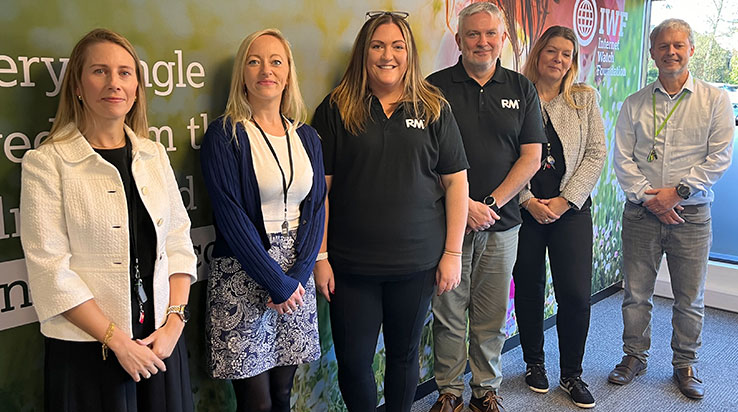Heidi Kempster, Deputy CEO of the Internet Watch Foundation (IWF) and Jason Tomlinson, Managing Director of RM Technology reflect on the organisations’ two-decade partnership tackling child sexual abuse material.

From left to right - Lene Neilsen, Development Officer at IWF, Penny Tyler, Development Officer at IWF, Tasha Hestock Product Manager at RM, Matthew Kelly of RM, Heidi Kempster, Deputy CEO and Chief Operating Officer of IWF and Neil Prowse, Development Manager of IWF.
Why are IWF and RM working together?
RM: Having been the UK’s first internet service provider (ISP) specifically for schools since 1995, RM launched its SafetyNet web content filtering product in 1997, shortly after the IWF was established. When SafetyNet was launched, maintaining the list of websites to block was a mostly manual process carried out by RM staff.
We became an IWF Member in 2004 because we recognised the importance of IWF’s work to protect those sexually abused in childhood and make the internet a safer place by identifying and removing online child sexual abuse images. By contributing to that work and drawing on the collective efforts of the membership we would be able to better ensure the safety of the students and staff in the schools we work with.
IWF: The Internet Watch Foundation was born in 1996 out of a desire to protect children from the evolving threat posed by the internet and new technologies. We’ve been defending children online ever since and a key part of that effort is the vital partnerships that have strengthened our abilities to do so.
The benefits of working with RM as an IWF Member were clear cut from the start as they shared our vision of making the internet a safer place for all children. RM’s SafetyNet tool uses the IWF dataset of URLs at the heart of its product, allowing them to swiftly block access to confirmed websites and webpages containing criminal child sexual abuse material.
What has changed during the partnership’s time?
RM: When we joined the IWF its block list contained fewer than 450 URLs. In 2023 the IWF URL List contained 194,580 unique URLs, with an average 8,351 URLs per day. This dramatic increase shows the importance of remaining vigilant about potential online harms.
The types of harm that people can encounter online have increased to include cyber bullying, sexual exploitation, cyber security threats and identity theft.
IWF: When we started in 1996, over 18 per cent of the world’s child sexual abuse imagery was hosted in the UK. Today that figure is less than one per cent, a testament to the hard work of our analysts to make the UK one of the most difficult places on the planet to host illegal images of children.
Since 2004, the services and tools that we can provide to Members to tackle child sexual abuse imagery have also expanded. RM now uses our Non-Photographic Imagery URL List of known webpages that show computer-generated imagery, drawn or animated pictures of children suffering abuse.
Sadly, the number of reports of child sexual abuse that the IWF sees continues to rise and last year we discovered more child sexual abuse imagery online than ever before. Emerging technologies, such as AI-generated child sexual abuse material also add to the complex challenge of tackling child sexual abuse online.

What have RM and IWF achieved together?
RM: By combining information from IWF and other sources into our SafetyNet content filtering service, together we help protect 1.5 million students and over 3,000 schools from child abuse and sexual exploitation material, as well as other online harms.
By contributing to funding the IWF during our 20 years of membership, we have helped advance the cause of online safety that the IWF so diligently works on.
IWF: When tech companies like RM help to fund the IWF they are investing in our vision to make the internet safer for all children. Their support allows us to help free child victims of sexual abuse from the trauma and anguish of knowing a record of their abuse is being shared online, again and again.
In 2023, the IWF investigated more than 392,000 reports suspected to contain child sexual abuse imagery. This is vital work involving the individual assessment of reports by our team of highly-trained analysts that can only be completed thanks to Member contributions.
What do you still want to achieve together?
RM: We intend to carry on supporting the IWF so it can innovate in the work it does. This will help to ensure the continued safety of students and staff in our schools and the wider community.
IWF: We want to continue to be a trusted source of expertise, providing cutting edge datasets and services to block and disrupt criminal content online, ultimately keeping even more children safe like those protected by RM’s technology.
What are your current concerns around protecting children from online threats?
RM: IWF’s recent ‘Think before you share’ campaign covers one of the areas that children need to be educated on when sharing content online. By helping adults address the topic with children it tackles one of the main barriers.
The use of AI in and out of schools continues to be an area of concern - while a great tool for learning, there are threats that come with it.
IWF: The threat from AI generated child sexual abuse material remains a concern as well as the highly targeted levels of sexual extortion that are being directed at children. Children are not to blame, they are often the victims of sophisticated crime gangs who mercilessly exploit their vulnerability for financial gain. We continue to drive awareness of this crime with children, their parents and educators.
Both RM SafetyNet and RM broadband connections for schools use information from the IWF to help keep pupils and staff safe from online child sexual abuse content.

Contact us to find out more about RM SafetyNet and RM Broadband.